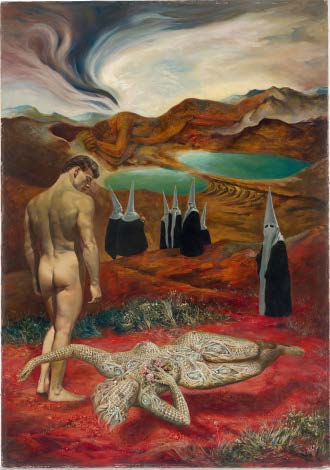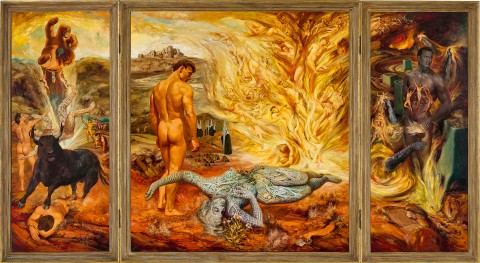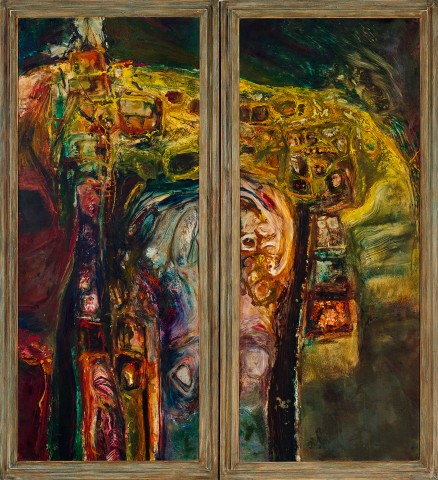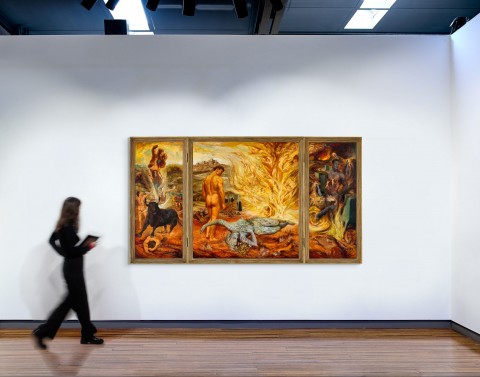Spain II, 1959 - 61
James Gleeson
oil on canvas and oil on composition board
triptych
121.5 x 211.0 cm (overall)
signed and dated right outer panel lower centre: J. Gleeson. 61
signed, dated and inscribed centre inner panel lower right: Opus / James Gleeson / 1959 - 1961
Honor Smith, commissioned directly from the artist
Estate of Edward M. Smith
Sotheby's, Sydney, 27 August 2001, lot 13 (as 'Spain - A Triptych')
Private collection, Melbourne
Spain, 1951, oil on canvas, 67.0 x 47.0 cm, National Gallery of Australia, Canberra
Sketch for painting 'Spain' #2 triptych, c.1950, drawing in pen, black ink and pencil, 13.4 x 23.2 cm, National Gallery of Australia, Canberra
1.jpg

James Gleeson was Australia’s best-known and most committed Surrealist artist. Over more than six decades, his unified oeuvre looked beyond observable reality, plumbing instead the furthest reaches of his unique, vivid imagination. Born in Sydney in 1915 and coming of age at the outbreak of World War Two, Gleeson’s formative years were profoundly marked by a pervasive atmosphere of violence, uncertainty and disorder. In a discussion with Lou Klepac in 1986, Gleeson reflected that he had initially subscribed to the socio-political ideology of Surrealism, in particular the possibility it offered to ‘keep the rational mind in balance and perhaps prevent such disasters as war, indifference and fanaticism.’1
Surrealism encouraged the use of an eclectic and highly personal mix of images to evoke the alternative reality experienced through dreams and differing mental states. In 1967, Sandra McGrath penned a profile of Gleeson for the periodical Art and Australia. In it, she explained, ‘As a painter within the context of Australian painting, he is curiously aloof and removed. He finds no inspiration in the barren Australian landscape or its meagre myths. He is no Williams or Nolan. Gleeson draws his warmth from the European tradition. He is wrapped in a classical mantle. He is absorbed sensuously in the Italian landscape, and intellectually it is the Greek myths rather than the Australian myths that capture his imagination.’2
With a monumental, dramatic and fearsome power, Gleeson’s altarpiece triptych Spain II records the artist’s transformative encounter with classical Europe in the years immediately following the end of World War Two. After having been long delayed, Gleeson’s modern European Grand Tour only began in 1947, when the artist was aged 32. There he read widely, met with influential Surrealists and viewed masterpieces of Western Art hitherto only known through reproduction. He spent three months in Italy, one month in Holland and four months in France, living the rest of the time in London, where he shared a close collaborative friendship with the Australian sculptor Robert Klippel.
Shortly after his return to Australia, Gleeson produced three major works poignantly expressing the devastation of war that he had seen in the ruined splendour of the Continent: Italy, 1951 (Art Gallery of New South Wales); Greece, 1951; and Spain, 1951 (National Gallery of Australia). Commissioned by Edward and Honor Smith, the imposing triptych Spain II was developed from the composition of its predecessor, becoming a more expansive narrative tableau with the addition of hinged side wings that fold in to cover the main image, each painted on the reverse with an abstract design. Compositionally replicating the biblical cycle of creation, temptation and fall that can be found in altarpieces of the late Medieval period and early Renaissance – for example, Hieronymus Bosch’s The Garden of Earthly Delights, 1490 – 1510 (Museo del Prado) – Gleeson’s Spain II displays the full panoply of his enigmatic visual symbology.
2.jpg

Although he had never been to Spain, James Gleeson was well read and had exceptional visual literacy, gleaning visual motifs from a myriad of sources.3 Gleeson’s discovery of works of art of the Italian Renaissance, particularly those by Michelangelo, opened his eyes to a Humanist conception of the world. Composed of a disorienting and unlikely blend of disparate elements, Spain II places an idealised man within the landscape alongside various objects and motifs evoking the essence of past times and the Spanish culture. The meticulously painted male nude in the centre of the composition – likely modelled on Gleeson’s life partner Frank O’Keefe, whom he had met in 1948 – echoes the pose of Michelangelo’s David and surveys impassively the oneiric scene that unfolds around him.
With a deliberate construction and painstaking realism verging on trompe-l’oeil, Gleeson creates a disjointed narrative. His juxtaposition of objects and scale replicates in paint the Surrealist techniques of collage, creating an overall fantastical effect reminiscent of paintings by Salvador Dalì, whose work Gleeson had encountered in the Herald Exhibition of French and British Contemporary Art in Sydney in 1939. Partly inspired by El Greco’s View of Toledo, 1596 – 1600, which Gleeson knew from reproductions4, the ominous threat of the Spanish Inquisition abounds in Spain II – from the hooded penitents beckoning in the middle distance, the abundance of crucifixion motifs, the distant citadel of Toledo and a charging bull. The surging flames consisting of writhing bodies are directly inspired by William Blake’s watercolour illustrations of the fires of purgatory created in 1824 to illustrate the inferno in Dante’s Divine Comedy (confirmed in the notes accompanying the sketch of Spain II held in the National Gallery of Australia). The curious four-sided vessels filled with skulls in the left-hand panel are a common motif in Gleeson’s works of the period, inspired by Sir Thomas Browne’s Hydriotaphia Urn Burial, 1658.5 The reclining female figure in the foreground, again reminiscent of the works of Dalì, is displayed with see-through skin, demonstrating Gleeson’s Surrealist interest in what lies beneath the surface. Although she is portrayed with stony grey skin encrusted with jewels quite different to the lifelike flesh of the men, she also expresses the power of regeneration, with flowers freshly blooming from her chest.
Painted at an early turning point in Gleeson’s career, Spain II contains many of the artist’s most iconic motifs, all combined in one ambitious multi-panelled work. It encapsulates the vividness of Gleeson’s subconscious imagination, while responding to contemporary social concerns and illustrating the astounding depth and breadth of his cultural literacy.
1. Klepac, L., James Gleeson. Landscape out of Nature, The Beagle Press, 1987, p. 14
2. McGrath, S., ‘Profile: James Gleeson’, Art and Australia, no. 5, vol. 3, December 1967, p. 253
3. Ryan, A., James Gleeson. Drawings for Paintings, Art Gallery of New South Wales, Sydney, 2003, p. 19
4. See Free, R., James Gleson. Images from the Shadows, Craftsman House, Sydney, 1996, p. 15
5. Discussion of this motif may be found in Kolenberg, H. and Ryan, A., James Gleeson. Drawings for Paintings, 2003, Art Gallery of New South Wales, pp. 13, 48
LUCIE REEVES-SMITH




